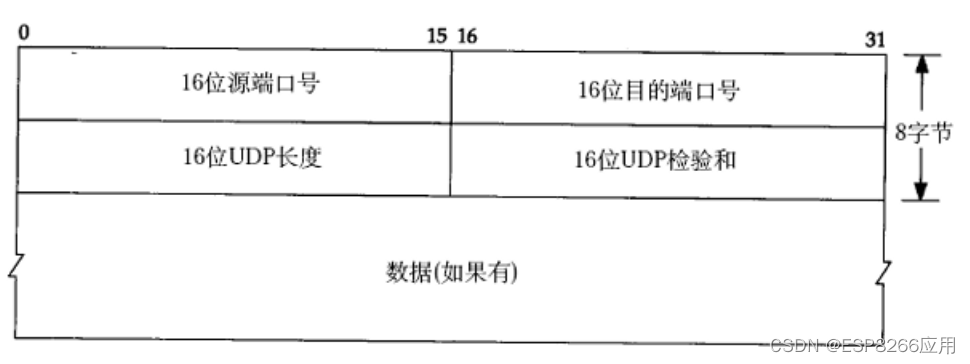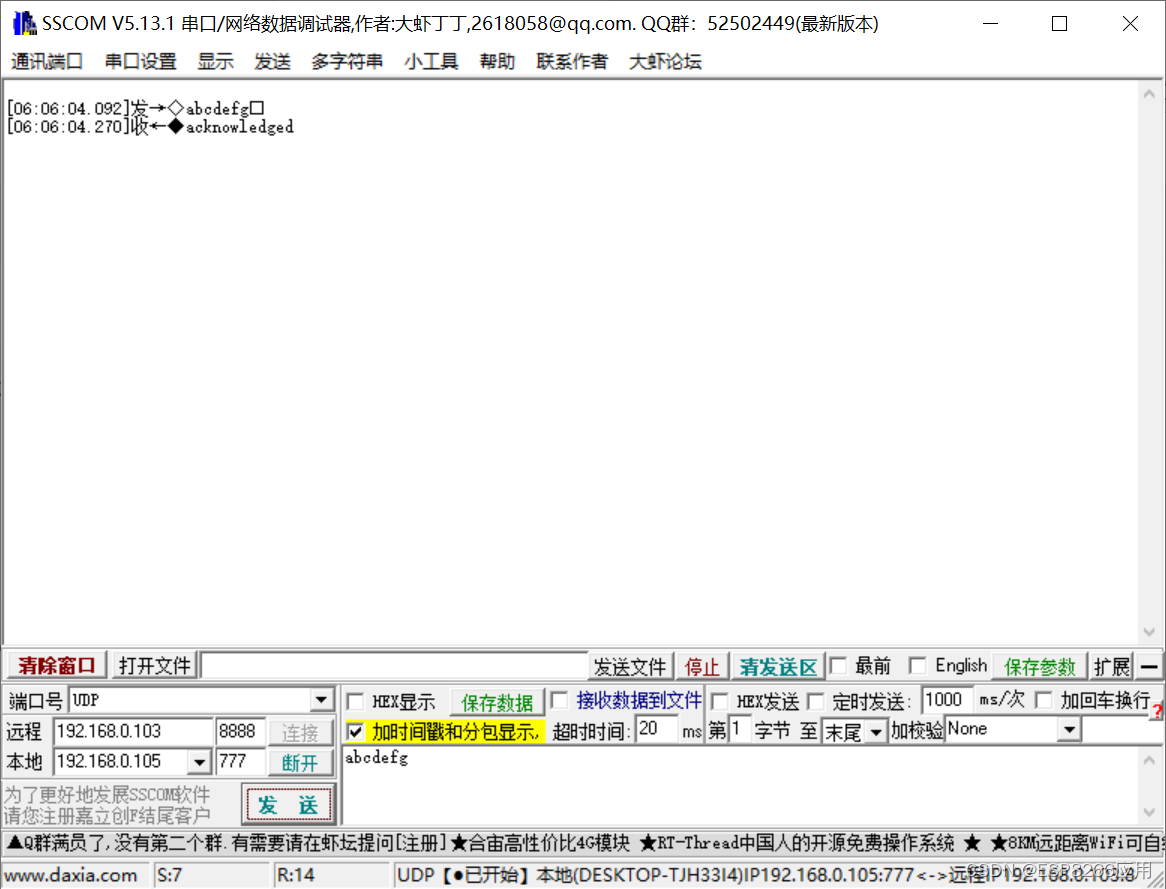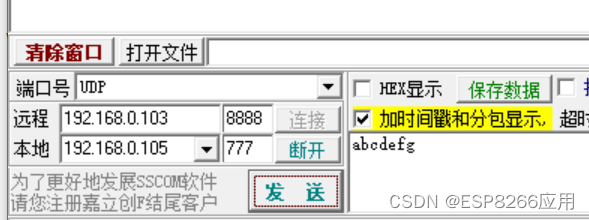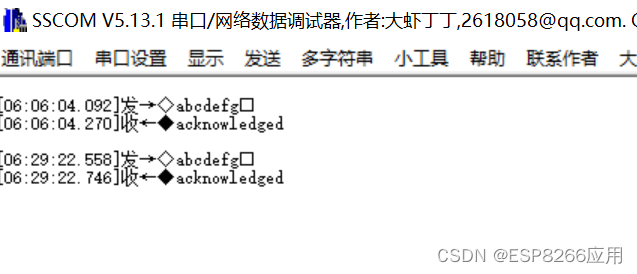目录
一、UDP协议概述
1、UDP基本概念
UDP(User Datagram Protocol)—— 用户数据报协议,是互联网传输层的一个重要协议。
UDP为应用程序提供了一种无需建立连接就可以发送封装的 IP 数据包的方法,允许应用程序在所需的层次上架构自己的协议之外,几乎没有做什么特别的事情。
UDP使用底层的互联网协议来传送报文,同IP一样提供不可靠的无连接数据包传输服务。它不提供报文到达确认、排序、及流量控制等功能。
由于使用UDP协议消耗资源小,通信效率高,所以通常都会用于音频、视频和普通数据的传输例如视频会议都使用UDP协议,因为这种情况即使偶尔丢失一两个数据包,也不会对接收结果产生太大影响。
2、UDP的主要特点
(1)UDP是无连接的协议。即在发送数据前不需要建立连接,发送数据结束也没有连接释放,因此减少了开销和发送数据前的时延。
(2)UDP使用尽最大努力交付。即不保证可靠交付,因此不需要维护复杂的连接状态表。
(3)UDP是面向数据报的。对于应用层交付的报文,发送方的UDP在添加首部后直接交付给IP层。UDP对应用层交付的报文,既不合并,也不拆分,而是保留这些报文的边界。也就是说,应用层给UDP多长报文,UDP就发多长,一次发送一个报文。
(4)在接收方的UDP,对于IP层交付的UDP用户数据报,在去除UDP首部后也直接交付应用层,不作任何处理,一次交付一个完整的报文。因此,控制报文长度的工作由应用层负责,应用层要选择合适大小的报文。若报文太长,UDP封装后交给IP层,IP层在传输时可能要进行分片处理,减低了IP层的效率。反之,应用层报文太短,效率也低。
(5)UDP没有拥塞控制机制。因此,网络出现的拥塞不会使源主机的发送速率降低。这对某些实时应用很重要,如IP电话,实时视频会议等,要求源主机以恒定的速率发送数据,并且允许在网络拥塞时丢失一部分数据,但不允许数据有太大的时延。
(6)UDP支持一对一,一对多,多对一和多对多的交互通信。
(7)UDP的首部开销小,只有8字节,比TCP的20字节的首部短。
3、UDP的基本报文格式
UDP报头由4部分组成:
源端口号:发送方的端口号。
目的端口号:目的主机的端口号。
UDP长度:UDP报文的长度,单位字节,包括报头和有效载荷。
UDP校验和:保证报文完整性和正确性,出错就丢弃。
 二、ESP8266官方UDP库相关函数详解
二、ESP8266官方UDP库相关函数详解
1. begin(uint16_t port)
功能:初始化 WiFiUDP库和网络设置,启动WiFiUDP套接字,侦听指定的本地端口
参数:port,指定侦听的本地端口号
返回值:1,成功;0,失败,表示没有可用的套接字
// initialize, start listening on specified port. // Returns 1 if successful, 0 if there are no sockets available to use uint8_t begin(uint16_t port) override; 2. available()
功能:返回当前数据包中,可从缓冲区读取的字节数。这是已经到达的数据。
参数:无
返回值:当前数据包中可用的字节数
注意:仅在调用解析数据包函数WiFiUDP.parsePacket()之后,才能成功调用此函数。
// Number of bytes remaining in the current packet int available() override; 3. beginPacket(hostName, port) 或 beginPacket(hostIp, port)
功能:开始构建数据包,准备写入数据,以发送到指定ip和端口的远程主机。
参数:远程主机的IP地址(或域名)和端口号
返回值:如果成功,则返回1;如果提供的IP地址或端口有问题,则返回0。
// Start building up a packet to send to the remote host specific in ip and port // Returns 1 if successful, 0 if there was a problem with the supplied IP address or port int beginPacket(IPAddress ip, uint16_t port) override; // Start building up a packet to send to the remote host specific in host and port // Returns 1 if successful, 0 if there was a problem resolving the hostname or port int beginPacket(const char *host, uint16_t port) override; 4. endPacket()
功能:写入UDP数据后,完成数据找包并发送。
参数:无
返回值:报文发送成功,返回1;如有错误,返回0
// Finish off this packet and send it // Returns 1 if the packet was sent successfully, 0 if there was an error int endPacket() override; 5. write(byte) 或 write(buffer, size)
功能:前者,将单个字节内容,写入UDP数据包;后者,将缓冲区中指定数目的字节数,写入UDP数据包。
参数:byte,发送的字节;buffer:数据缓冲区指针;size,缓冲区大小。
返回值:写入UDP数据包的字节数。
注意:此函数必须包装在beginPacket()和endPacket()之间。其中,beginPacket()初始化数据包,endPacket()完成数据包的发送。
// Write a single byte into the packet size_t write(uint8_t) override; // Write size bytes from buffer into the packet size_t write(const uint8_t *buffer, size_t size) override; 6. parsePacket ()
功能:开始处理下一个可用的传入数据包
参数:无
返回值:返回数据包的大小(以字节为单位),如无可用的数据包,则返回0
注意:在使用UDP.read()读取缓冲区之前,必须先行调用parsePacket ()。
// Start processing the next available incoming packet // Returns the size of the packet in bytes, or 0 if no packets are available int parsePacket() override; 7. peek()
功能:从当前数据包中读取并返回下一个字节,但并不向前移动到下一个字节。也就是说,对peek()的连续调用将返回相同的值,与对下一个read()的调用相同。
返回值:下一个字节或字符;如果没有可供读取的字节则返回-1
// Return the next byte from the current packet without moving on to the next byte int peek() override; 8. read() 或 read(buffer, len)
功能:前者,从当前数据包中读取一个字节;后者,从当前数据包中读取 len 个字节的数据,并将其存入buffer指定的缓冲区。
参数:buffer,将要保存数据的缓冲区指针;len,要求要读取的字节数。
返回值:前者,读取到的字节数据;后者,读取到的字节数。如无可供读取的字节则返回0
注意:在函数 parsePacket() 执行成功之后,才能调用此函数
// Read a single byte from the current packet int read() override; // Read up to len bytes from the current packet and place them into buffer // Returns the number of bytes read, or 0 if none are available int read(unsigned char* buffer, size_t len) override; 9. flush()
功能:等待发送所有传出字符,此调用后输出缓冲区将被清空
// wait for all outgoing characters to be sent, output buffer is empty after this call void flush() override; 10. stop()
功能:断开 UDP 连接,释放 UDP 会话期间所使用的资源。
// Finish with the UDP connection void stop() override; 11. remotelP()
功能:获取发送当前数据包的远程主机的IP地址
返回值:发送当前数据包的远程主机IP地址(4个字节的IPAddress结构)
注意:必须在WiFiUDP.parsePacket()之后,才能调用此函数
// Return the IP address of the host who sent the current incoming packet IPAddress remoteIP() override; 12. remotePort()
功能:获取远程连接主机的端口号
返回值:发送当前数据包的远程主机的端口号
注意:必须在WiFiUDP.parsePacket()之后,才能调用此函数
// Return the port of the host who sent the current incoming packet uint16_t remotePort() override;三、建立UDP服务器的一般流程
1、将ESP8266模组或开发板设置在station工作模式:WiFi.mode(WIFI_STA)。
2、将ESP8266模组或开发板接入到WIFI 网络:WiFi.begin(SSID,PSSD)。
3、实例化 WiFiUDP对象,开始在指定侦听端口号建立UDP连接,启动自动侦听。
4、等待输入的UDP包,处理收到的数据,并回复客户端请求的信息。
四、ESP8266官方库 UDP 示例程序演示
启动 ArduinoIDE,从菜单栏依次点选【文件】——【示例】——【ESP8266WiFi】——【UDP】,在IDE窗口主界面打开官方 UDP 示例程序。
将程序编译\上传到NodeMCU-ESP8266开发板。 
/* UDPSendReceive.pde: This sketch receives UDP message strings, prints them to the serial port and sends an "acknowledge" string back to the sender A Processing sketch is included at the end of file that can be used to send and received messages for testing with a computer. created 21 Aug 2010 by Michael Margolis This code is in the public domain. adapted from Ethernet library examples */ #include <ESP8266WiFi.h> #include <WiFiUdp.h> #ifndef STASSID #define STASSID "xcb940" //将SSID更改成可用的名称 #define STAPSK "87589940abc" //更改成可用的密码 #endif unsigned int localPort = 8888; // local port to listen on // buffers for receiving and sending data char packetBuffer[UDP_TX_PACKET_MAX_SIZE + 1]; // buffer to hold incoming packet, char ReplyBuffer[] = "acknowledged\r\n"; // a string to send back WiFiUDP Udp; void setup() { Serial.begin(115200); WiFi.mode(WIFI_STA); WiFi.begin(STASSID, STAPSK); while (WiFi.status() != WL_CONNECTED) { Serial.print('.'); delay(500); } Serial.print("Connected! IP address: "); Serial.println(WiFi.localIP()); Serial.printf("UDP server on port %d\n", localPort); Udp.begin(localPort); } void loop() { // if there's data available, read a packet int packetSize = Udp.parsePacket(); if (packetSize) { Serial.printf("Received packet of size %d from %s:%d\n (to %s:%d, free heap = %d B)\n", packetSize, Udp.remoteIP().toString().c_str(), Udp.remotePort(), Udp.destinationIP().toString().c_str(), Udp.localPort(), ESP.getFreeHeap()); // read the packet into packetBufffer int n = Udp.read(packetBuffer, UDP_TX_PACKET_MAX_SIZE); packetBuffer[n] = 0; Serial.println("Contents:"); Serial.println(packetBuffer); // send a reply, to the IP address and port that sent us the packet we received Udp.beginPacket(Udp.remoteIP(), Udp.remotePort()); Udp.write(ReplyBuffer); Udp.endPacket(); } } 五、ESP8266官方库 UDP 程序运行说明
1、将程序编译并上传到开发板。
如在串口监视器可以看到如下信息,说明程序已成功运行。
信息提示:(1)开发板成功连接到本地WiFi,获取到IP地址为:192.168.0.103。
(2)建立UDP服务器成功,并在8888端口启动侦听。

2、运行串口网络数据调试器 对UDP服务器进行测试。
(1)调试工具:SSCOM V5.13.1 百度网盘点击下载, 提取码:b89u。

(2)运行调试工具,按照开发板串口输出信息中的UDP服务器IP地址和端口号,设置调试工具窗口左下角的远程主机IP地址和端口号,本地IP地址和端口号由软件自动填充。
(3)点击调试工具窗口左下角【连接】按钮,在右下角空白窗口输入待发送的信息,再点击【发送】按钮,就可以向UDP服务器发送信息了。

(4)如果信息发送成功,开发板串口监视器和调试工具上方的信息窗口,就可以看到有关信息了。


